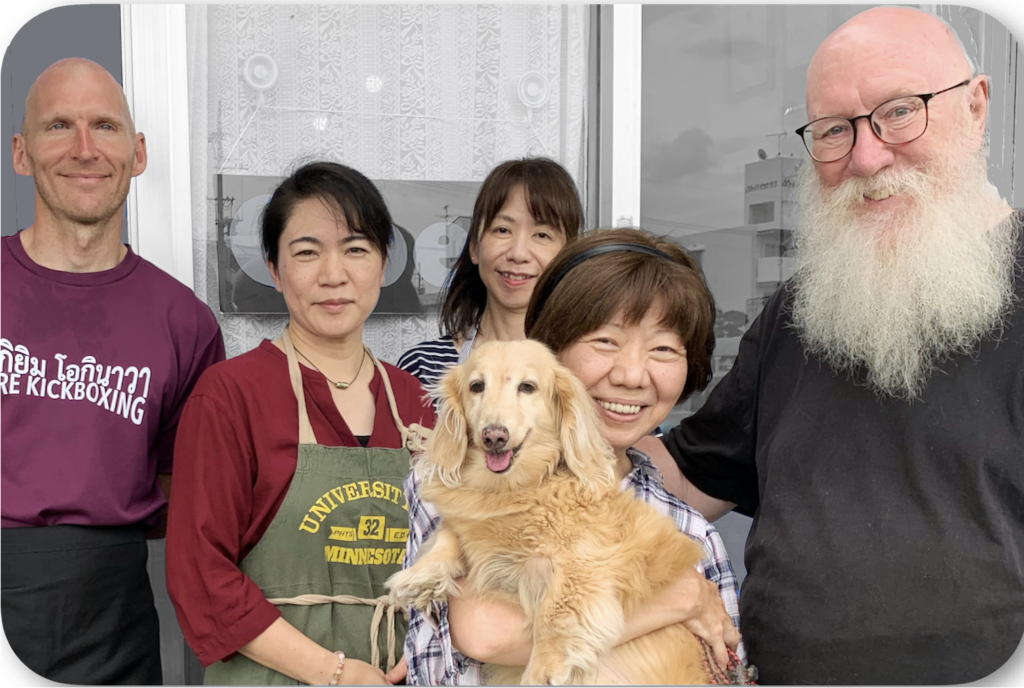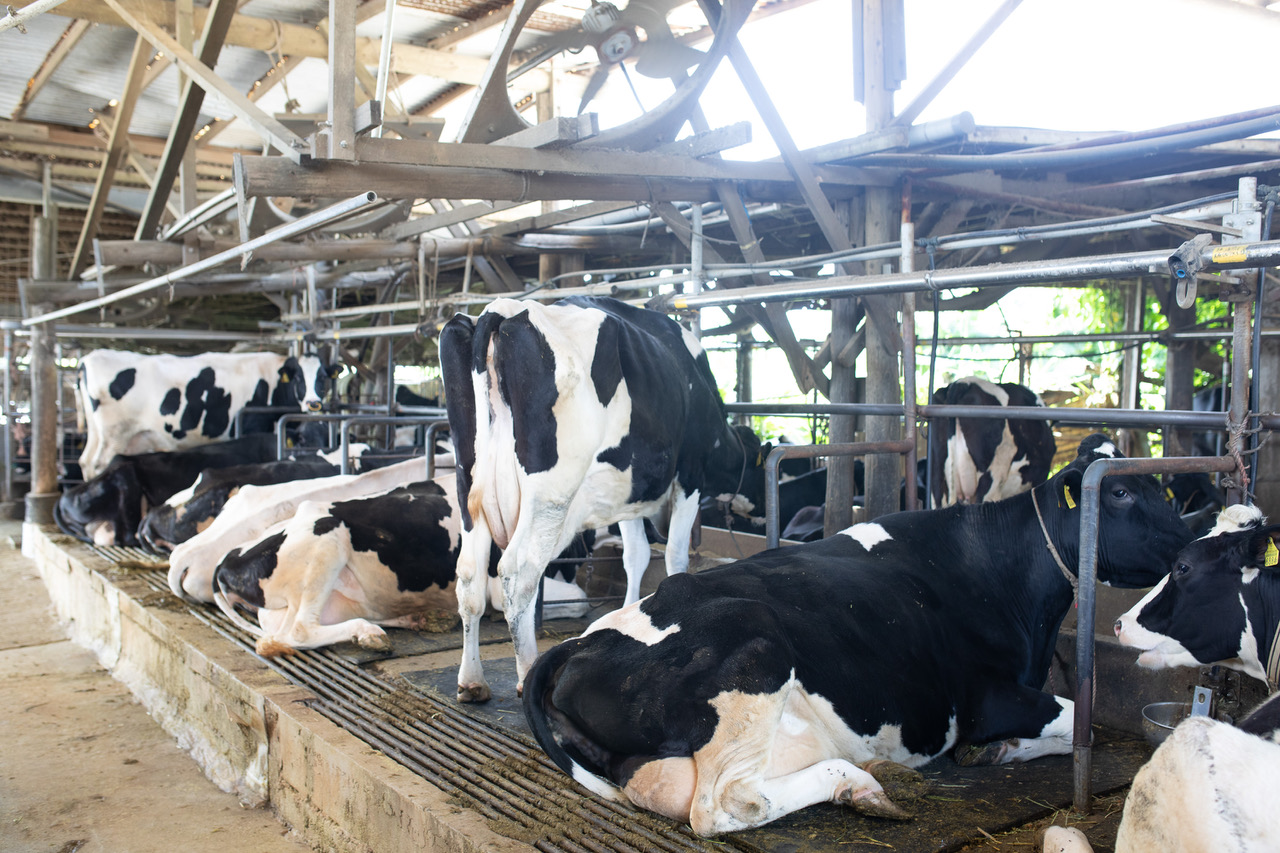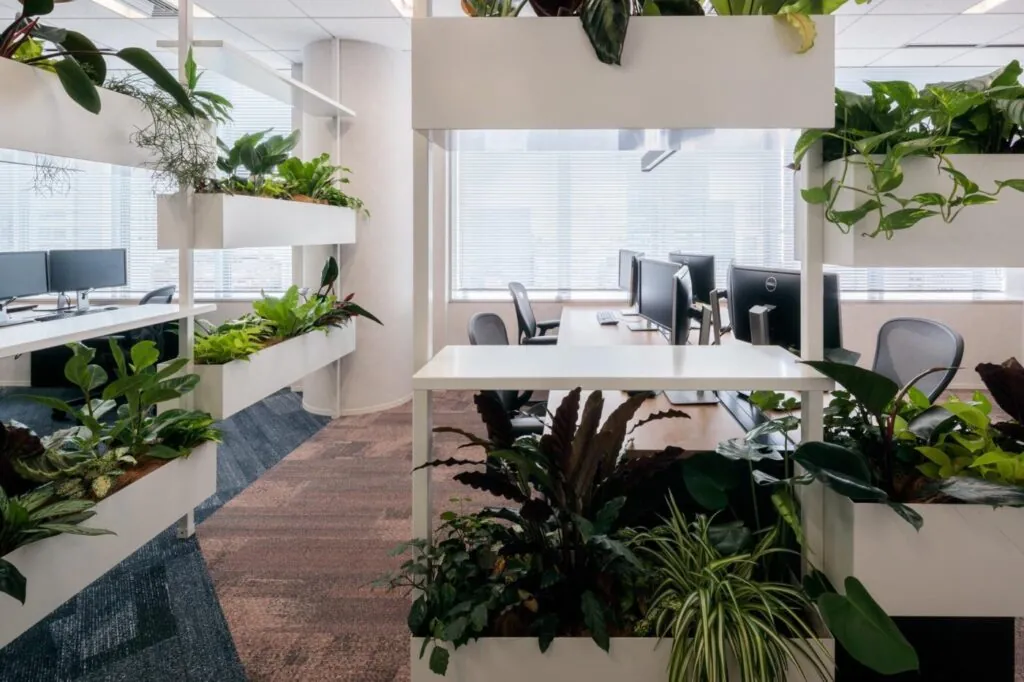Member? Please login
How ‘Real’ Cheese Came to Okinawa: The story of John Davis, Okinawa’s Legendary Cheese Guy

Written by BCCJ
January 15, 2024
Member News
This article was originally published for the Okinawa Heartbeat, and written by John Davis himself.
John Davis, aka ‘The Cheese Guy in Okinawa‘ tells the story of what brought him to the island, why he started making cheese and how his business took off.
When I was a kid, there was always cheese in the kitchen, and it was very good cheese too! If you were hungry, a slice of bread and a hunk of cheese was the perfect snack! As a teenager, I lived in Wiltshire, near Cheddar and mum always kept plenty of that wonderful sharp cheese in the larder.
But when I came to Japan in 1976, it was virtually cheese-less. I managed to find a supermarket in Tokyo with a “cheese section.” Cheese section? This consisted of two kinds of cheese, one square, precut into slabs and the other triangular, each piece wrapped in aluminium foil. Neither would melt – even with a blowtorch – and both tasted, well, let’s just say they resembled cheese in the same way that astroturf resembles a real lawn.
Obviously that wasn’t going to satisfy my cravings. So every time I came back from a trip abroad, I brought back a whole suitcase bursting with cheese. Fortunately, as the years went by, things began to improve. The international stores in Tokyo began stocking a broader selection of high-quality cheeses and I was happy.
Moving to Sapporo
After 15 years in overcrowded Tokyo, fed up with the pollution and lack of space, I moved to Sapporo. I converted an old yakitori shop into a school and started up business there. This was now the 90’s and the eikawa boom had cooled, but the school did well, and the supermarkets had a decent selection of cheese.
But, after a while, we began to weary of the six months of snow and ice every year and decided to move south to Okinawa. So, we packed the car with the essentials, which included a crate of wine and some cheese, drove down to Tomakomai and boarded the ferry to Naha. The trip was incredible, especially the last section, from Osaka, through the Seto Inland Sea, down past Amami Oshima and along the coast to Naha port. There were flying fish and dolphins following the ship and the sunsets and sunrises over the ocean were truly breathtaking.
Leaving Hokkaido in mid-October, the air had been quite cold, but day by day, as we travelled slowly southward, it became gradually warmer until, when we disembarked in Naha a week later, we were wearing T-shirts and short pants!
We rented a weekly mansion and set about to explore the island and find a suitable place to live. We settled in Oroku near the airport and spent a very happy year or so, just taking it easy.
But for the lack of cheese, life was good. Unfortunately, as far as fermented curd was concerned, Okinawa in the noughties was not unlike Tokyo in the 70’s – cheeseless! And that just wouldn’t do, because what I needed was cheese with character and Japanese industrial cheese had about as much character as the background music they play in airports: something you wouldn’t actively object to, but nothing you would go out of your way for either.
Learning How to Make Cheese in Okinawa
As I had time on my hands, I had the idea of solving the cheese problem by making my own. Okinawan milk was good – rich and creamy – and the temperature range was similar to Southern Italy. It should therefore be possible to make good cheese, I thought.
I read everything I could find about cheesemaking. It was fascinating and it didn’t look difficult! The only problem was finding basic ingredients like starter cultures and rennet on an island that was essentially a cheese desert. But I did manage to find these items on the internet and a visit to Daiso and a smattering of hardware stores enabled me to put together the rudimentary equipment I needed.
Early Attempts at Cheese Making
My first couple of attempts proved to me that it was possible to turn liquid milk into solid cheese. The results were edible, but not particularly inspiring. This was encouraging though, and I persevered.

The third attempt was the breakthrough! I made a camembert infused with porcini. It wasn’t all that difficult. The only hard part was waiting five weeks for it to mature. When the day came, we bought some decent wine, opened the bottle to let it breathe and took out the cheese. It was positively superb! My wife and I were in cheese heaven and each had multiple “cheesegasms.” We were hooked. This was far better than the cheese in any supermarket!
Every morning, I would go on a “milk hunt,” looking for milk that was near the sell-by-date. I’d go back home and make a cheese. I’d make the same cheese on successive days until I could do it without looking at the recipe, then I’d move on to another. It wasn’t long before I was creating original cheeses. One of the most interesting of these was a total invention. I made it with kuro koji, the yeast that’s used to make awamori, the Okinawan liquor, instead of starter culture. A very special cheese, we christened this “Ryukyu Crown.”
A year or so later, when my refrigerator was stuffed full of all kinds of cheese creations, a friend suggested having a “cheese night” at his bar in Naha. It was a big success!
“This beats retirement!” I thought. So I set off on another milk hunt, this time for a reliable source of raw milk. A bar owner friend came to the rescue. A distant relative of his, (the bar owner’s wife’s cousin’s next door neighbor’s uncle’s half cousin), whose name was Kiyoshi runs a dairy farm in Nanjo, Okinawa. He wanted to make cheese, but didn’t know how. I needed raw milk, but didn’t know where to get it. We each had what the other wanted, so it wasn’t long before we were shaking hands and making plans.
Launching a Cheese Business in Okinawa
 Kiyoshi gave us space to build a cheese factory and we were rocking and rolling! Most of the heavy equipment was built for us by a stainless steel fabricator nearby. This was much cheaper than buying ready-made equipment on the internet, and much better because it was built to our specifications. Daiso was very useful, supplying trays, knives and other bits and pieces, and even, incidentally, cheesecloth! The initial investment wasn’t much. We spent about ¥400,000 to build the factory and outfit it with rudimentary equipment.
Kiyoshi gave us space to build a cheese factory and we were rocking and rolling! Most of the heavy equipment was built for us by a stainless steel fabricator nearby. This was much cheaper than buying ready-made equipment on the internet, and much better because it was built to our specifications. Daiso was very useful, supplying trays, knives and other bits and pieces, and even, incidentally, cheesecloth! The initial investment wasn’t much. We spent about ¥400,000 to build the factory and outfit it with rudimentary equipment.
Soon, the inspections were done and we had our license! We were up and running, making cheese and selling at the local farmer’s market. Another friend introduced me to a chef at the Ritz Carlton. After that, things just exploded and we were supplying most of the big hotels on the island.
We opened our cheese shop in Nanjo about ten years ago and, more recently, started selling online. Since then, in addition to being on TV many times, we’ve been written up in articles in local media and even won awards from the local government for services to Okinawa. Now, we’re well known in Okinawa and we regularly ship cheeses to customers in mainland Japan and even Hokkaido.
Quality Okinawan Cheese Comes at a Price
Occasionally I’m asked why our products are more expensive than those in supermarkets. The answer is simple. The real thing is always going to be more expensive than a mass produced imitation.
I’ll never forget walking through the streets of Rome many years ago and stopping at a fruit juice stand for freshly squeezed orange juice. Two large oranges would be cut in half and the juice squeezed into a glass. That glass contained orange juice and NOTHING else. This was more expensive than the cartons of so-called “orange juice” in supermarkets, but it tasted divine and you knew that it wasn’t mixed with preservatives, coloring agents, etc.
Similarly, we only use the fresh full-cream milk from the cows on our dairy farm. The whole point of the exercise is to make REAL cheese, cheese with character, not the bland low-average industrial imitation everyone has gotten used to.
More than Cheese
We also make yogurt. We DON’T use preservatives, sugar, fructose, sucrose, artificial flavorings, coloring agents or thickeners. Our yogurt is made with just milk, straight from the cows in our dairy farm. Someone once asked if our yogurt was “gluten free!” “Of course!” I answered, “why wouldn’t it be? It’s yogurt.” Curious, I picked up a pack of “Greek” yogurt in a supermarket and read the list of ingredients. One of them was “FLOUR!”
That’s why our products are more expensive. We don’t cut corners. You get what you pay for.
Uniquely Okinawan Cheese

The names of cheeses are often the names of the places where they were born. Cheddar is a small town and cave system in the Southwest of England. Camembert, Gorgonzola, Oaxaca, Parmesan, are all place names. The cheese of an area celebrates that area. And the people who live there fiercely support it.
Our cheese does the same, which is why you’ll find names in our catalog such as Chura Nanjo, Ozato White, Ryukyu Crown and Ozato Basil [pictured], named after the city and region where our farm and dairy are located. We celebrate our local area with the special herbs and spices that grow here. And local support for our products can be seen in the many awards we have received.
Why Make Cheese in Okinawa?
The temperature range is similar to other world-famous cheesemaking regions, such as Sicily in the Mediterranean and Oaxaca in Mexico. With a level of humidity that really helps fermentation, Okinawa is a superb place to make cheese.
Of course, climate is not the only factor in making great cheese. Our products are built on the foundation of original recipes and hard-won know-how. But the cornerstone of our cheese’s strong appeal is the fact that it is Okinawan through and through. We are lucky to have access to not only the best milk on the island, but some of the best milk in the country. This is not the product of a homesick foreigner trying to recreate his life back home. This is Okinawan cheese.

A Marriage of Cultures
The old name for Okinawa is “Ryukyu.” Right in the center of that word are the initials “UK,” “ryUKyu.” This symbolises what we are trying to do.
Historically, there never was a cheese culture in Okinawa. There could have been, all the ingredients were there, but for some reason it didn’t develop here. So, I thought that by combining our (UK) cheesemaking know-how and Okinawan herbs, spices, tastes and, of course, milk, we could create one.
And I think we have.
John Davis, The Cheese Guy in Okinawa
Website: https://thecheeseguyinokinawa.com/








